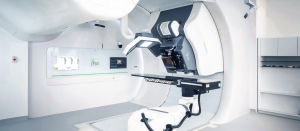por
John R. Fischer, Senior Reporter | December 06, 2023

IBA ProteusOne (Photo courtesy of IBA)
In collaboration with radiotherapy device maker IBA, the University of Kansas Medical Center (KUMC) will investigate the potential of ConformalFLASH technology to spare healthy tissue while treating cancer as part of a preclinical research trial.
ConformalFLASH technology combines ultrahigh dose rates with the Bragg Peak properties of protons for reducing tissue toxicity. The Bragg Peak effect plots energy loss from ionizing radiation as it travels through matter, occurring immediately before the protons come to rest. As a proton travels to greater depths and lower speed, the absorbed dose increases, hitting its “peak” when the proton comes to a final stop.
The researchers will evaluate the effects of this technology on skin and muscular normal tissue following proton FLASH irradiation, and compare their findings to electron FLASH machines, which can only deliver FLASH dose rates to superficial tumors; and protons transmission FLASH delivery, which has reduced conformality and higher integral doses compared to ConformalFLASH technology.
“We are eager to continue pushing the boundaries of knowledge on FLASH and sharing this expertise with our large community of IBA centers,” said Olivier Legrain, chief executive officer of IBA, in a statement.
FLASH doses are typically applied at rates of 40-60 Gy/s, and have been found in preclinical research to spare normal tissue from damage while precisely targeting and effectively destroying tumors. This allows providers to administer treatment in smaller amounts, in one to five fractions, rather than 25 to 30, significantly shortening treatment courses for patients.
For their work together, KUMC will use an IBA ProteusONE machine, which comes equipped with pencil beam scanning to reduce exposure, and embedded X-ray and cone-beam CT imaging at isocenter. Both previously published a joint abstract, "Experimental demonstration of 360nA FLASH proton beam current via synchrocyclotron using IBA Proteus®ONE,” during the Proton Therapy Co-Operative Group (PTCOG) Congress 2023, in Madrid, in June.
In 2022, IBA
started the ConformalFLASH Alliance to foster research collaborations like this to investigate the potential of this approach.
Earlier this year, it
began a similar partnership with Belgian researchers at the Particle Therapy Interuniversity Centre Leuven (PARTICLE), on the UZ Leuven health sciences campus.
“If FLASH protects normal tissues but does not protect the tumor, a Phase I clinical trial in humans can be envisaged,” professor Dr. Karin Haustermans, medical director of PARTICLE, told HCB News at the time.
KUMC did not respond in time for the publication of this story.
